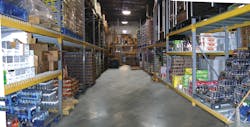A vending operation’s warehouse can significantly contribute to the company’s bottom line. While an efficient warehouse can cut costs for an operator, a poorly run warehouse can lead to inadequacies in delivery service, product spoilage and disorganized space.
Warehouse automation helps operators overcome these challenges by giving them the data they need to cut inefficiencies and regain control of inventory, which is important when managing vending and micro markets.
Pre-kitting is king
In vending, one of the first steps to creating an efficient warehouse is to pre-kit, or, load deliveries based on a location’s needs. Pre-kitting has been shown to increase revenue by route, lower vehicle inventories and result in a more efficient truck loading/machine filling process.
Pre-kitting is not new to the industry, but it’s an integral part of managing the warehouse, says Randy Smith, former operator and CEO of LightSpeed Automation. “You’re not competing if you’re not pre-kitting,” he said. “Early on we [operators] found that pre-kitting significantly reduced spoilage, we didn’t necessarily have to order by the pallet anymore and yet we were able to ensure that the right product was getting where it needed to be.”
Dan Kust, purchasing manager for BE’S Coffee & Vending Service located in Green Bay, WI, saw firsthand the advantages of pre-kitting when he realized that it had reduced his inventory by 40 percent. The company was able to customize machines by location and eliminate the rolling warehouse.
Advancements in technology throughout the years have even made pre-kitting more feasible by helping to eliminate human error, too. When Rod Nester, president of Smith Vending located in Clarinda, IA, took over the company in 2008, he knew that in order to streamline his entire business and cut inefficiencies, he had to begin in the warehouse.
Although it took several years, he was able to invest fully in an automated warehouse. With warehouse automation, Nester saw more accurate pre-kits, the elimination of bad data — which he describes as inaccurate information — and a return on investment in six months. “We thought we were doing a great job picking on paper but we weren’t as efficient as we thought,” he said. “Warehouse automation gave me total control over my inventory,” he said.
Pre-kitting is often the first step in warehouse automation. Because it is driven by a vending management system (VMS), it gives operators the data to know what product is coming in and out of the warehouse, an extremely important factor in vending and when expanding into micro markets, too.
Markets need an agile warehouse
With warehouse automation, operators can increase efficiencies like ordering products by the case, rather than the pallet as well as eliminating unnecessary pick crew staff and spoilage of products, which is one of the biggest warehouse problems, says Randy Smith. “Spoilage can be a killer to operators and micro markets worsen that problem because of the sheer amount of SKUs possible.” Just like in a grocery store, he says, customers in micro markets can open the door and pull the freshest salad, “Then the salad that is set to expire the next day goes untouched.”
Technology, however, has helped operators like Nester know exactly what’s selling so he can order the precise amount and get the product off of his shelves as quickly as possible. “The minimum amount of days on the shelf, the better,” he said.
Jeff Smith, president of All Star Services located in Port Huron, MI, agrees. “We have instituted a just-in-time inventory system in our warehouse where product is received and transferred out as quickly as possible to avoid accumulating it within our existing warehouse space and to get the best dates to our customers,” he said. He recommends ordering by the box, if possible, to keep the cost of inventory down.
Nester believes that operators today don’t have to be traditional when it comes to ordering product. “We used to buy product because it was on sale but that caused inventory issues and we had a lot of product sitting around,” he said. “Now we think ‘What can we sell that our customers want to buy?’”
Technology helps operators customize machines and markets, which aids in eliminating the amount of wasted food. When introducing micro markets, Randy Smith recommends that operators start with core items and expand their offerings from there to avoid unnecessary spoilage. “I’ve seen some operators offering more than 500 SKUs and then they end up with multiple products that go stale. The products just sit in the warehouse and don’t move and take up room,” he said. “Operators don’t necessarily have to order by the pallet anymore and that comes into play with customizing the machines and markets — you know what’s coming in and going out.”
Kust notes, however, that in the beginning it was difficult to order product when BE’S was just getting started in micro markets. “With one to three markets it’s hard to bring in a variety of product and move it quickly,” he said. The company had trouble moving product off of the shelves, but as it grew its market base, that issue resolved itself. “We found that five to six markets was a good range to keep a steady flow of inventory.”
Once the flow of product is under control in a warehouse, operators have a better opportunity to use the overall space more wisely, too.
Smart spaces
BE’S Coffee & Vending Service opened its first micro market in Nov. 2013 and has grown to 32 markets in a little under two years. The company had no intention of expanding its 8,000 sq. ft. warehouse to cater to this new segment, said Kust. “So we just simply had to find a way to use the space more wisely.” The company used picking zones in the warehouse, and decided to extend that strategy as it expanded into micro markets. The five picking zones include snack, pastry, Avenue C product, beverages and cooler/freezer product. BE’s increased from 100 lights on its LightSpeed FastTrack system to 150 because micro markets offer a larger variety of products than vending. In addition the company added two iPads to its electrical pallet jack so employees could pick four orders — either vending or micro market — at one time.
Kust noted that one unforeseen challenge is the inefficiency of staff picking from so many different zones for a single micro market location. “It can be taxing for them,” he said. “And we could be more efficient if our cooler was closer to the line, but that is something we will have to figure out along the way.”
When Jeff Smith introduced micro markets in 2011 he realized he needed to reorganize his warehouse space. “We changed the layout of the company’s pre-pick line to meet the needs of the new micro market items,” he said. “We did not have to expand our actual space, we just had to reset it to accommodate our needs.”
To tackle the added inventory in the warehouse when Smith Vending added micro markets, Nester doubled the size of his pre-kit area and his climate-controlled space to accommodate refrigerated items. He additionally created a space in his warehouse specifically for micro market products. Like many operators, Nester uses the data he collects to make decisions about rearranging his warehouse space, rotating product, combating spoilage and maintaining overall efficiencies.
Fluid relationship
As micro markets continue to permeate the industry, the issue of warehouse efficiency will continue to gain importance. Finding space to carry enough products for the ever-changing consumer demand in micro markets will be a constant challenge, as will monitoring that product to make sure it sells.
Warehouse automation can help a vending operator reach a new level of profitability, and even launch micro markets. It includes investing in technology that allows for pre-kitting, a zoned warehouse, a picking system and sales reporting, which will drive up profits.
Sidebar 1: (can this be like ‘thought’ bubble next to the first subhead when I discuss Dan Kust, please?)
Operator advice:
Unexpected challenges with pre-kitting—
Kust warns operators that although pre-kitting creates efficiencies off of the truck, it oftentimes means that the inefficiencies are moved to the warehouse. “When you start pre-kitting, cardboard will be a huge issue,” he said. “We have bins that the picker has to put the cardboard in, but then there is the time that someone spends removing the cardboard.”
Sidebar 3:
Technology and the small operator
Gary Nelson, president of Liberty Vending Inc. located in Denver, CO, considers himself a small operator who is focused on technology to make his warehouse more efficient. Although Nelson doesn’t operate micro markets, he encourages all operators, no matter what segments they offer, to invest in technology. “Warehouse management systems are an absolute must to alleviate employee frustration, ensure date control, pre-kitting accuracy, and space positioning for correct product ordering,” he said.
In 2006 his company moved to a new warehouse and began using roller shelving to create aisles, which he believes allows the company to produce a good pre-kitting efficiency. “This is great for the smaller operators that unpack the pallets. Since this shelving style has been installed, we have effectively pre-kitted all products for all our routes for 10 consecutive years.”
About the Author

Adrienne Klein
Contributing Editor
Adrienne Zimmer Klein is a freelance writer with a background in the vending, micro market and office coffee service industry. She worked as an associate editor and managing editor at Automatic Merchandiser and VendingMarketWatch.com from 2013 until 2017. She is a regular contributing writer at Automatic Merchandiser.
